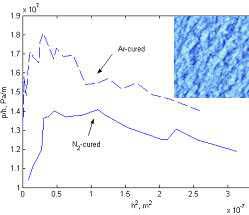Preparation and Characterization of Polyimide Thin Film Nanostructure Orientation and Material Properties
Xue-feng Lin*, a, David A. Groveb, Jordan Alexanderb, Robert W. Odoma, and Patricia M. Lindleya
aCharles Evans & Associates,
810 Kifer Road, Sunnyvale, CA 94086 USA
bLuxel Corporation, 515 Tucker Avenue, Friday Harbor, WA 98250 USA
This is an abstract
for a presentation given at the
Ninth
Foresight Conference on Molecular Nanotechnology.
There will be a link from here to the full article when it is
available on the web.
The development and characterization of polyimide thin films has attracted increasing attention. Characteristic properties of high thermal stability, reliable mechanical strength, and low dielectric constant make polyimide valuable in micro and nano-scale electronics and nonlinear optics devices. Devices such as wave guides, electronic conducting models, and liquid-crystal sensors all utilize oriented polyimides. Therefore, the demand for well-defined and well-characterized oriented polyimides has initiated intensive studies of polyimide thin film preparation methods, as well as characterization approaches of resultant chain structures and their material properties.
In our study of polyimide thin films, particular attention was focused on characterizing the effects of imidization parameters on material properties and nano-structures of biphthalic dianhydride (BPDA/PPD) polyimide. The effects of thermal imidization were evaluated over a range of temperatures using both nitrogen and argon atmospheres. Atomic force microscopy (AFM) measurements reveal the nano-scale chains of polyimide, as well as the variation of chain structures arising from different imidization processes. High-resolution analysis exhibits fine structures consisting of locally organized two-dimensional close-packed polymer molecules that are often curled and distributed in a random fashion (see Figure 1 inset). These close-packed molecular structures originate from molecular self-interactions. Fine oriented chain structures are initially observed at low imidization temperatures. Increasing this temperature enhances chain mobility resulting in a phase transition of the polyimide in which the observed chain morphologies range from quasi-ordered to amorphous. In this study we also explore the effects of the AFM cantilever tips on imaging of polyimide chain structures.

Bulge testing is used to determine residual stress (s0), biaxial modulus (M), and ultimate strength differences of films resulting from the various cure processes. The p/h vs. h2 curve (p = pressure, h = bulge-height) is the bulge test's precursor to the stress-strain curve, from which s0 and M are derived. Figure 1 shows this curve for polyimide films cured in N2 and Ar inert atmospheres. This demonstrates some of the effects alternate atmosphere cures have on polyimide thin-film material properties. The N2 film has s0 = 1.4x108 Pa and M = 1.4x1010 Pa, and the Ar film has s0 = 2.2x108 Pa and M = 1.6x1010 Pa.
Abstract in RTF format 8,472 bytes
*Corresponding Address:
Xue-feng Lin
Charles Evans & Associates
810 Kifer Road, Sunnyvale, CA 94086 USA
Phone: (408) 530-3896 or 3887
Email: (408) 530-3501
Email: [email protected]
http://www.cea.com
|